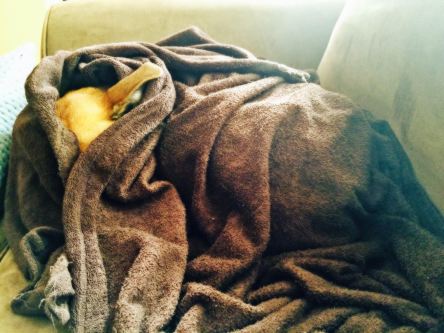
Hocus Pocus and the Kitty Boyz did quite well during the pre and post Halloween festivities because we set everyone up for success, but that doesn’t necessarily mean everyone is Cool and The Gang afterward. The day after a cacophony of commotion is often when families observe their pets becoming irritable and reactive. We refer to this as trigger stacking.
Trigger stacking is how stress hormones can create a cluster effect of reactive behavior. This kind of behavior is also seen in humans; think about when you have lost your temper after one stressful thing after another happens. When an individual is pushed over their threshold, we see reactivity. A ‘threshold’ is the point at which one reacts. They quickly switch from an operant-thinking-mode to a non-thinking-survival-mode.
When the non-thinking-survival-mode kicks in the individual will either fight, flight (flee), fiddle, or freeze. Below are The 4 F’s – 4 common behavior patterns that animals (and people) will do when afraid or feeling threatened:
- Flight
- Fight
- Freeze
- Fiddle About
Stress is both a physical and mental problem.
Stressful events affect all living beings, even on the cellular level. And be aware: these stress hormones don’t just disappear once the stressful event is over. The stress hormones can last for days, and even weeks with some individuals.
When conditions in the environment continue to stack up, and when multiple triggers (stressors unique to the individual animal) happen close together, or at the same time, they can have a cumulative harmful effect on the animal. These stress hormones cause the animal to behave in a way that he/she normally would not.
Over the years we have observed each animal in our home respond with a different type of reactivity to their individual perceived threats. The dog has been known to lunge and bark, freeze and growl, or retreat. Her response depended on what she felt threatened by, and by her individual stress/hormone levels at that moment. Each of the cats has their own individual response, depending on the trigger at the time, and their individual stress hormone levels. You might recall one of your animals behaving this way when they are stressed. You might even recall doing this yourself!
Cortisol is an adrenal hormone with a great number of effects on the body. The level goes up or down quickly in response to stress.
Pet owners will often see this kind of reactivity when multiple stimuli occur in a short period of time (example: Halloween!) It’s important to know that we don’t get to decide what’s stressful for the animal; these stimuli are anything that the individual animal is sensitive to. A reactive animal can be sensitive to dogs, cats, people, sounds, objects, and/or their environment. This sensitivity can be displayed by various types of reactive behavior such as running, hiding, freezing, growling, hissing, air snapping, biting, and guarding resources such as food, bedding, spaces, people, etc.

365 days a year we do our best to help every animal in our home to feel safe and secure. We continue to counter condition each animal to their individual perceived threats, and we strive to set them all up for success. We use tools and techniques to ensure their perceived threat level is at zero. But these are only pieces of the peaceful puzzle.

Reducing Stress Levels by Creating “Down Time”
How do you feel when you are tired and irritable after a long stressful day? Our animal companions feel this and more when they are forced to participate, or even observe our human shenanigans. Just watching and listening to so many strange sights and sounds can greatly increase their stress hormone levels! But we can help them recover by giving them a “cortisol vacation.” One of the most loving and helpful things we can do as animal guardians is offer all of the animals in our home plenty of safe, quiet places of refuge, especially after busy weekends such as this one. We can create plenty of “pet down time.” We can do this by encouraging them to take naps, get plenty of deep sleep, and lots of rest. We can create a peaceful, calm environment. Think of ways that you can create peaceful personal retreats for every living being in your home, including yourself!

Boundaries, Please.
Creating safe boundaries is an essential key to creating peace and harmony in your home, especially after stressful festivities. If you have children, guide them by showing them how to to respect the animal’s space or enclosure. Teach them to be mindful and respectful of each individual animal’s tolerance for noise and commotion. Ensure that the pets have their own safe bubble where they are free from being “loved on” (AKA being pestered). If you have family or friends visiting, remind them to give the animals space. If the animals choose to be around your guests, remember that the dog or cat may be excited to see newcomers, but in the next instant they very well could be more protective of things they consider “high value” such as bedding, treats, their people, and their food. Remember those stress hormones are in their system! Also, if the animals in your home are not the best of buds, and they’re merely coexisting with one another, creating safe spaces for each animal and managing your home environment carefully is imperative. Give everyone ample safe space!
Being aware of each animal’s individual threshold, and their need for safe, quiet refuge after any kind of commotion is how we become conscious companions for the animals with which we share a home.
Was your family prepared for the festivities this year? How did your animal companions do during the commotion? Are you all having a relaxed Sunday together? How do you help your animals and yourself decompress after big events?
Blessings of peace to you and yours!




Very helpful! It’s easy to forget that our fur, feathered, scaled etc. friends don’t know why humans do these crazy things.
LikeLiked by 1 person
Thank you! Yeah, the crazy things we humans do for fun and amusement are often not appreciated or understood by the wee animal kingdom in our homes 😉 Our menagerie is happy for a sleepy Sunday!
LikeLike
Pingback: Will It Be The Eve of Chaos or Calm? | Conscious Companion
Pingback: Thanksgiving Tips for Busy Families (plus silly bloopers) – Conscious Companion
Pingback: Compassion and Calculated Creativity: Stepping Outside the Proverbial Pet Box – Conscious Companion